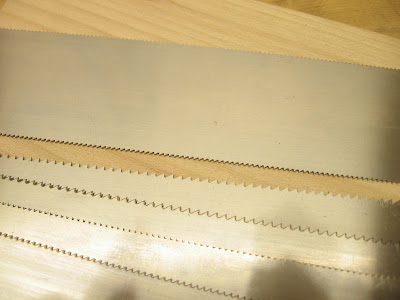Hi again,
Hunting through my junk pile today. I discovered the blade of a small (8” x 3”)) brass-backed Spear & Jackson tenon saw. There’s no longer a handle, although I still have the three nuts, one with the S&J logo. And for some reason, I filed off all the teeth (please don’t ask me why - this all happened back in the old days, before I got the true religion, back when terrible and barbaric things were done to old and innocent tools).
- this all happened back in the old days, before I got the true religion, back when terrible and barbaric things were done to old and innocent tools).
The blade plate is flat (about 0.025” thick), and the back is heavy, folded brass, so I’d like to resurrect it into something useful But I feel rather daunted by the task : my only experience so far is of sharpening a 12 tpi crosscut saw, and of re-setting a 17 tpi gents saw.
I was thinking of a 15 tpi (or thereabouts), rip-cut, dovetail saw.
Am I setting my sights too high, for someone of my limited experience?
The main problems, as I see them, are: basic re-shaping of the teeth to 15 tpi ; and making the handle.
1. Re-shaping the teeth
How can I cut the teeth evenly? I guess I need a template of some sort. Is there something I can use – I vaguely remember reading about using a power hacksaw blade as a template, but I can’t find the reference.
Any ideas, please, for how to go about laying outand filing the tooth pattern?
2. Making the handle
I’ve read several threads in this forum about making your own handles (and very nice they are too!). But mostly the makers start from the pattern of an existing, much-loved handle. My other back-saws, however, are fairly clunky modern things. If I’m going to start from scratch (as I must, since I’ve discarded the original handle) I might as well try to make an elegant and comfortable new one.
So, to get started, I need a shape which is more than just visual guesswork. Is there anywhere online I can get plans or layouts for suitable saw handles?
Any guidance you can offer will be gratefully accepted I rather suspect this is beyond my current skill level, so I shall not take “forget it!” amiss.
Regards
Chris
Hunting through my junk pile today. I discovered the blade of a small (8” x 3”)) brass-backed Spear & Jackson tenon saw. There’s no longer a handle, although I still have the three nuts, one with the S&J logo. And for some reason, I filed off all the teeth (please don’t ask me why
The blade plate is flat (about 0.025” thick), and the back is heavy, folded brass, so I’d like to resurrect it into something useful But I feel rather daunted by the task : my only experience so far is of sharpening a 12 tpi crosscut saw, and of re-setting a 17 tpi gents saw.
I was thinking of a 15 tpi (or thereabouts), rip-cut, dovetail saw.
Am I setting my sights too high, for someone of my limited experience?
The main problems, as I see them, are: basic re-shaping of the teeth to 15 tpi ; and making the handle.
1. Re-shaping the teeth
How can I cut the teeth evenly? I guess I need a template of some sort. Is there something I can use – I vaguely remember reading about using a power hacksaw blade as a template, but I can’t find the reference.
Any ideas, please, for how to go about laying outand filing the tooth pattern?
2. Making the handle
I’ve read several threads in this forum about making your own handles (and very nice they are too!). But mostly the makers start from the pattern of an existing, much-loved handle. My other back-saws, however, are fairly clunky modern things. If I’m going to start from scratch (as I must, since I’ve discarded the original handle) I might as well try to make an elegant and comfortable new one.
So, to get started, I need a shape which is more than just visual guesswork. Is there anywhere online I can get plans or layouts for suitable saw handles?
Any guidance you can offer will be gratefully accepted I rather suspect this is beyond my current skill level, so I shall not take “forget it!” amiss.
Regards
Chris


































